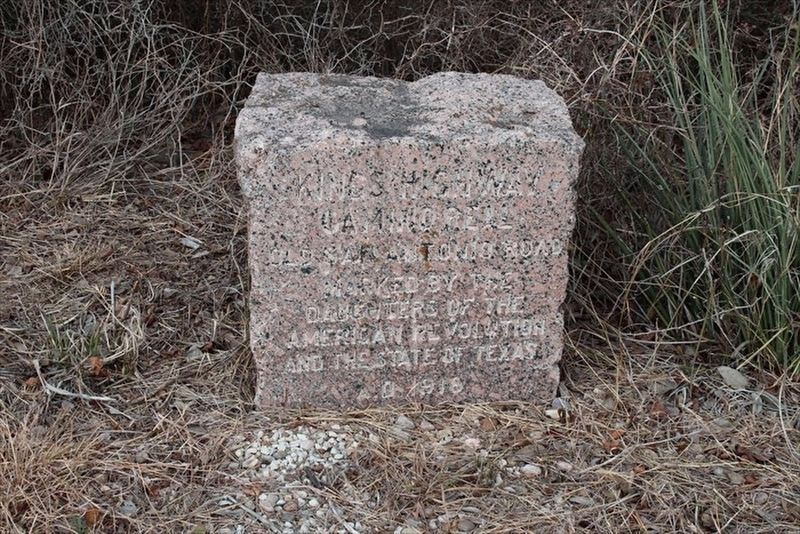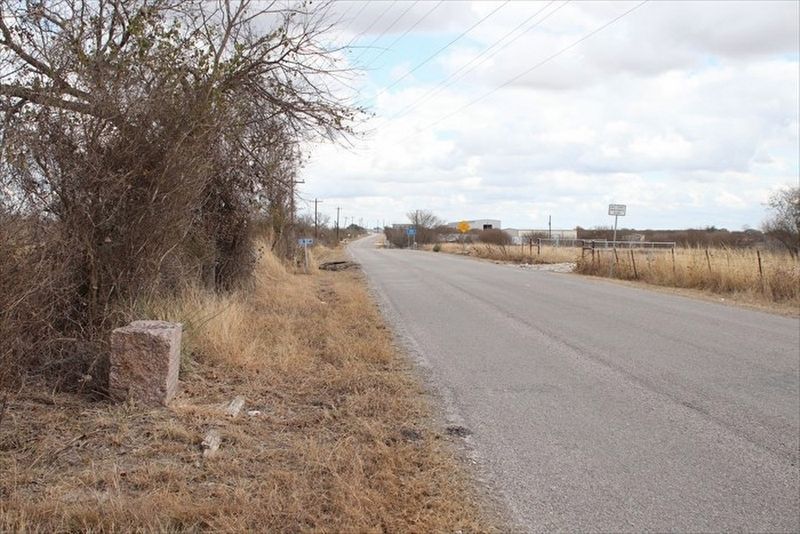Near Hunter in Comal County, Texas — The American South (West South Central)
Kings Highway Camino Real — Old San Antonio Road
Marker #76
— El Camino Real de los Tejas National Historic Trail —
Inscription.
Kings Highway Camino Real Old San Antonio Road
Marked by The Daughters of The American Revolution and The State of Texas A.D. 1918
Erected 1918 by The Daughters of The American Revolution (DAR) and The State of Texas. (Marker Number 76.)
Topics and series. This historical marker is listed in this topic list: Roads & Vehicles. In addition, it is included in the Daughters of the American Revolution series list. A significant historical year for this entry is 1918.
Location. 29° 47.662′ N, 98° 0.836′ W. Marker is near Hunter, Texas, in Comal County. Marker is on Old Bastrop Road, one mile east of York Creek Road, on the right when traveling west. Touch for map. Marker is at or near this postal address: 7325 Old Bastrop Rd, San Marcos TX 78666, United States of America. Touch for directions.
Other nearby markers. At least 8 other markers are within 7 miles of this marker, measured as the crow flies. Riley's Tavern (approx. one mile away); Kings Highway (approx. 3.1 miles away); a different marker also named Kings Highway Camino Real — Old San Antonio Road (approx. 3.2 miles away); Pitts Cemetery (approx. 3.3 miles away); First Baptist Church (approx. 4.1 miles away); The Cattle Drives (approx. 4.3 miles away); Redwood Cemetery (approx. 6.4 miles away); Belvin Street Historic District (approx. 6.6 miles away).
Regarding Kings Highway Camino Real — Old San Antonio Road. “During the Spanish colonial period in North America, numerous “royal roads”—or caminos reales—tied far-flung regions of the empire to Mexico City. One particular collection of indigenous trails and trade routes became known as El Camino Real de los Tejas, the primary overland route for the Spanish colonization of what is today Texas and northwestern Louisiana. The trail’s name is derived not only from its geographic extent but also from some of its original users. Spaniards referred to a prominent group of Caddo Indians as the Tejas, a word derived from the Caddo term for ‘friend’ or ‘ally.’ Thus, the Spanish province of Tejas, the Mexican state of Coahuila y Tejas, and the historic trail traversing them owe their name to the Caddo language.
El Camino Real de los Tejas served as a political, economic, and cultural link between Mexico City and Los Adaes (and all points in between). Settlers, missionaries, soldiers, servants, and indigenous allies followed various roads and trails along the 2,500 miles of this route to populate the settlements, missions, and presidios of eastern Texas and northwestern Louisiana. Linking a variety of cultural and linguistic groups, the royal road served as an agent for cultural diffusion, biological exchange, and communication and as a conduit for exploration, trade, migration, settlement, and livestock drives. Spanish, Mexican, French, American,
Black, and American Indian travelers along El Camino Real de los Tejas created a mix of traditions, laws, and cultures that is reflected in the people, landscapes, place names, languages, music, and arts of Texas and Louisiana today.” (NPS)
In 1915 the Texas legislature appropriated $5,000 to survey and mark the route. The Daughters of the American Revolution and other organizations sponsored and endorsed the project, and professional surveyor V. N. Zivley was commissioned to make the study. From 1915-18, the State of Texas and the Daughters of the American Revolution together placed 123 pink granite markers about every five miles along the King’s Highway, also known as Camino Real or Old San Antonio Road
The El Camino Real de los Tejas National Historic Trail is a national historic trail covering the U.S. section of El Camino Real de Los Tejas, a thoroughfare from the 18th-century Spanish colonial era in Spanish Texas, instrumental in the settlement, development, and history of Texas. The National Park Service designated El Camino Real de los Tejas National Historic Trail as a unit in the National Trails System in 2004. (Wiki)
Credits. This page was last revised on May 10, 2023. It was originally submitted on May 9, 2023, by Carolyn Sanders of Plano, Texas. This page has been viewed 53 times since then and 12 times this year. Photos: 1, 2. submitted on May 9, 2023, by Carolyn Sanders of Plano, Texas. • James Hulse was the editor who published this page.

